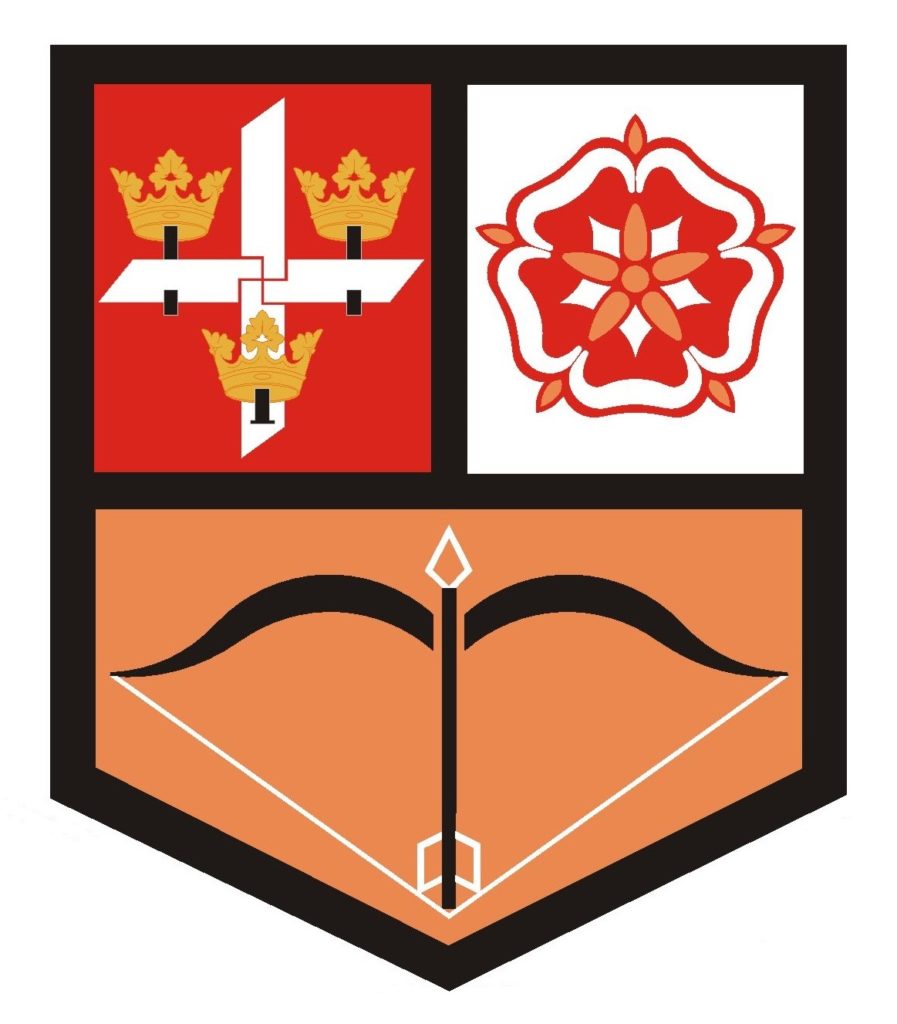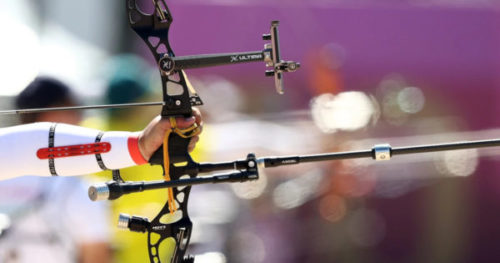
Olympic Recurve archery has a long and storied history that dates back thousands of years.
Recurve archery is the most common of all bow styles and you’ll see recurve bows with sights & stabilisers used in Olympic competitions. In an Olympic Recurve event, archers shoot as individuals and teams over a distance of 70 metres at a target face which has a diameter of 122cm with the innermost 10-point ring measuring just 12.2cm in diameter.
A recurve bow has ‘limbs‘ at the top and bottom of a ‘riser‘, that curve forward at their tips to give the bow more power. It’s this limb shape that gives the bow its name.
Parts of the Olympic Recurve bow …
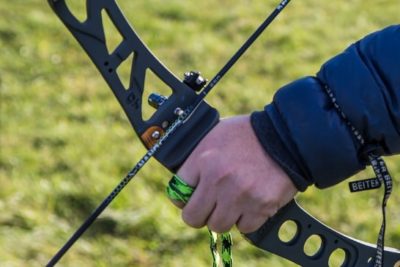
Riser
The riser is the central part of the bow where it’s held by the archer, and where the limbs and other parts attach. A standard riser is usually 25 inches long (measure from limb-bolt to limb-bolt centres, + 5 inches). If you combine this with the length of the limbs, you’ll get your bow length (a 25″ riser with ‘medium’ limbs, will give you a 68″ bow). A shorter riser and short limbs may be better for a junior archer. Risers are available in lengths between 17 and 27 inches – and in left or right-handed versions of course …
Limbs
‘International Limb Fitting‘ (ILF) is a common standard for risers on Olympic Recurve bows. The advantages of ILF bows are that the limbs ‘plug’ into a ‘standard’ fitting on the riser. That means you can purchase a pair of limbs that have a low draw weight when you start your archery, and then as you progress, you can change these for a stronger weight set. Limbs are marked as ‘short’, ‘medium’ or ‘long’ – and are also marked with a draw weight at a 28″ draw length. Limbs are usually made from layered materials that may include; carbon fibre, foam, bamboo, wood and/or plastics.
Formula limbs look similar but have different fit technology. If you have a ‘Formula‘ bow (common with ‘Hoyt’), then you need ‘Formula’ limbs, as ILF will not fit that riser …
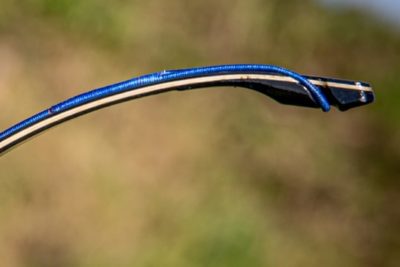
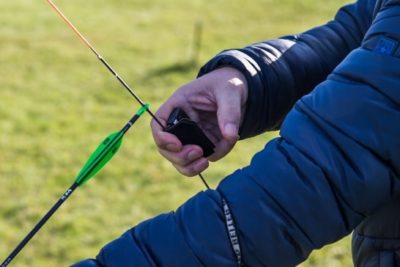
String
Bowstrings should be purchased to match the length of your bow (see Riser above). There are various coloured & multi-coloured strings – and you may find that certain colours aid aiming under natural light (e.g. dark colours), while other colours may suit artificial light. Two-colour strings will show their twists which can help to set and maintain ‘brace height‘. It is useful to note that while the string is obviously vital to shoot the arrow with, it also forms part of your sighting system when aiming your arrow and therefore, its colour can make a difference.
Pressure Button (a.k.a. “Plunger”)
When an arrow is shot, it deforms down its length and kicks sideways against the arrow rest. A pressure button acts as a shock absorber to reduce the effect of the arrow flexing & ‘kicking’ the riser as it leaves the bow. Pressure buttons do need to be ‘tuned’ to not only allow the arrow to sit correctly on the bow, but to also have the correct pressure for their shock-absorbing role.
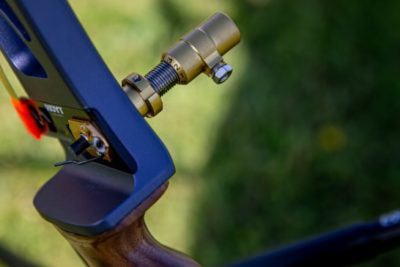

Clicker
A clicker is used on a recurve bow, to ensure that your draw length is consistent before arrow release. The arrow is loaded under the clicker, and it’s drawn back until the point passes the clicker bar. The bar will then spring onto a post or plate mounted on the riser, making an obvious ‘click‘ noise indicating that you are at optimum draw length and should now release the arrow. Hopefully, at the ‘click’, you will be sighted on the correct aiming point!
Arrow Rest
The arrow rest is simply there to cradle the arrow so that the arrow aligns centrally with the pressure button. More sophisticated arrow rests include a swing arm that’s held extended by a small magnet allowing the arm to be easily pushed out of the way by the fletchings of the arrow as it passes. The rest also includes a hole to allow the pressure button to protrude onto the arrow.
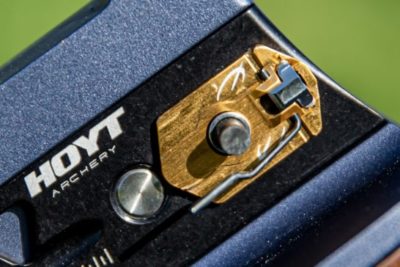
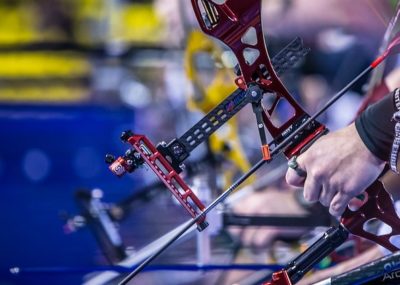
Sight
A bow-sight is a complex and [can be an] expensive piece of hardware mounted to the bow riser. Sights should offer up/down movement of the sight reticule for different distances, left/right movement of the reticule to compensate for wind & to tune the bow, and the extension bar should also be moveable – in & out – to bring the reticule closer for longer distances. The more expensive sights usually offer more robustness (sights have to absorb shooting shock & vibration), lower weight (carbon-fibre components), and adjustment knobs that are graduated with fine click-stops.
Arrows
Arrows can be wooden, aluminium, carbon, or a carbon/aluminium combination. Choosing the right arrow stiffness and length for you & your bow is vital! You must never use an arrow that is too short because, when you draw it, there is a risk it can fall off the arrow rest and damage the bow or, worse, damage you! Don’t hesitate to get an expert involved in your choice of arrows, as it can be an expensive waste if you choose the wrong arrow specifications.
- Shaft: This is the main body of the arrow, and can be solid wood, or an aluminium, carbon or composite [aluminium/carbon] tube.
- Nock: The nock is the grooved component at the end of an arrow that clips onto the bow string.
- Fletchings: These plastic or feather attachments are glued at the back of the arrow shaft, and they help to provide stability during the arrow’s flight.
- Pile: The pile (a.k.a. ‘point‘) is the sharp metal tip of the arrow. They are usually made of heavier metal than the shaft to help the arrow fly straight.
Here’s a guide to everything you wanted to know (and didn’t want to know) about tuning your arrows …
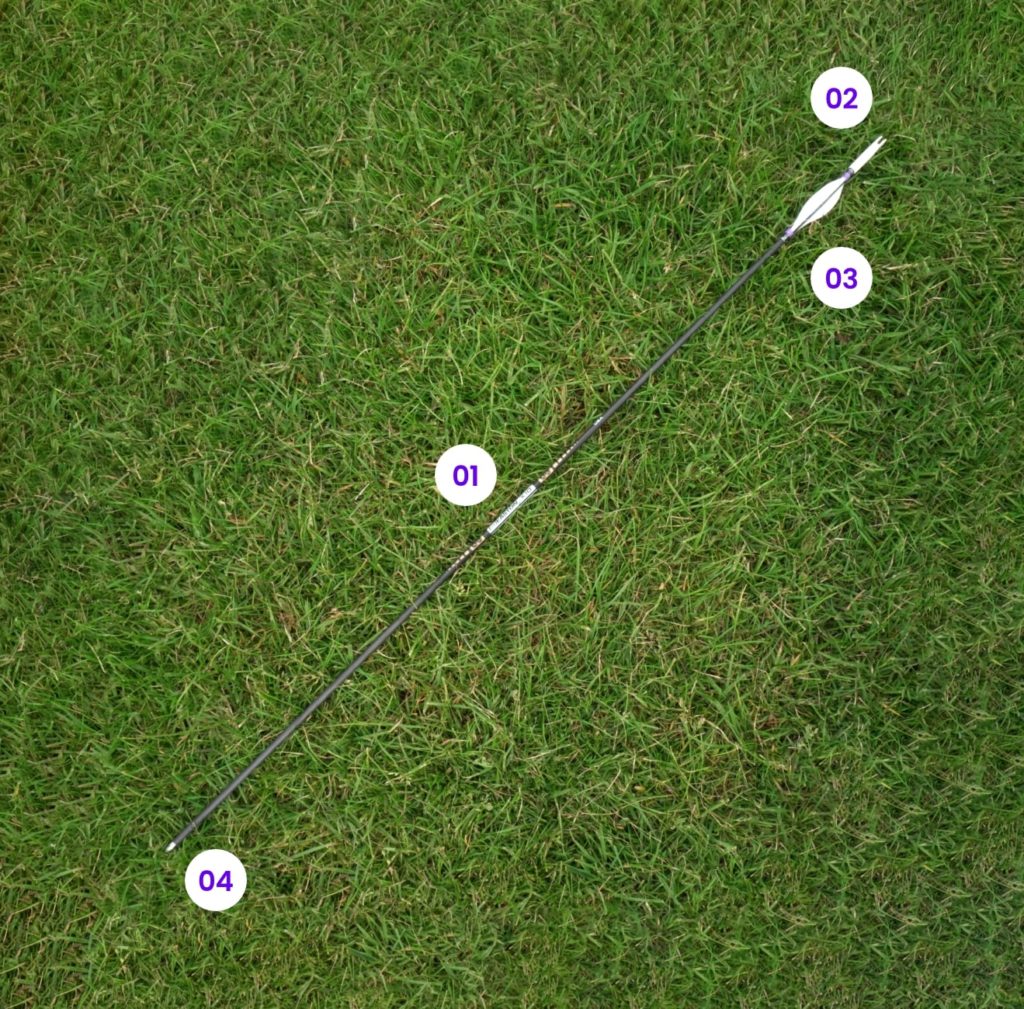
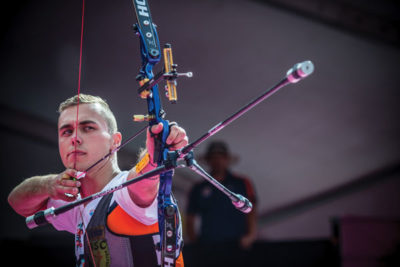
Stabiliser rods
Stabiliser rods are useful to add weight to a bow to balance it in your hands and to absorb some shock of arrow release. Stabilisers are like the long poles that tight-rope walkers use to balance with. In addition to absorbing some shock during arrow release, they extend ‘mass’ outward from the bow which balances it, steadies it and makes it easier to aim. A ‘full set’ of stabilisers will consist of; a short 5 or 6 inch ‘extender‘, a ‘V-Bar‘, a ‘Long rod‘, a pair of ‘Short rods‘, rubber ‘dampeners‘ on the end of each long & short rod, and ‘weights‘ to add to each dampener.
Other useful Accessories …
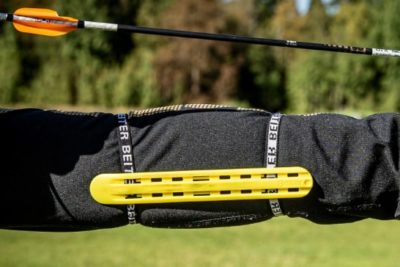
Arm Guard
An arm guard is useful to prevent the bowstring from hitting your clothing or your arm (ouch! – that hurts!!!) and interfering with a clean release of the arrow.
Finger Tab
A finger tab protects your fingers as you draw and release the bowstring. Finger tabs may have a spacer on the outside that helps to prevent your fingers from pinching the arrow nock.
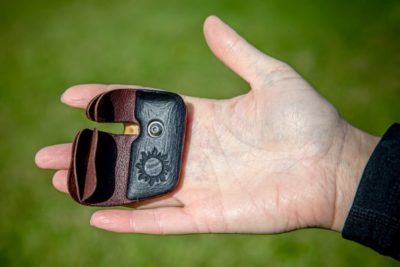
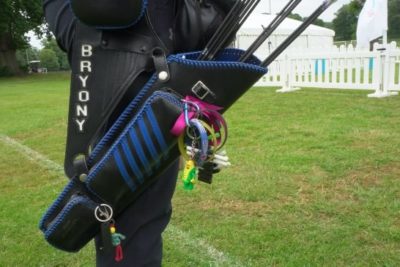
Quiver
A quiver is an obvious and useful accessory to carry your arrows – but also useful to pin your badges to – and to carry other useful items like your finger tab, arrow puller, basic tools and a pen for recording scores.
Bow Stringer
These straps are designed to make it easy and safe to get the bowstring on and off your bow without damaging the bow (or even damaging yourself!).
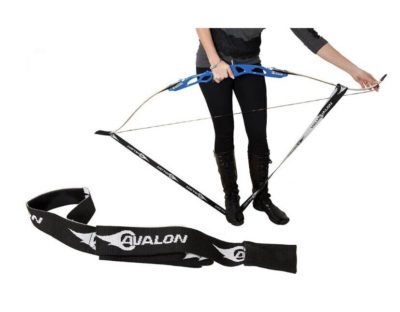
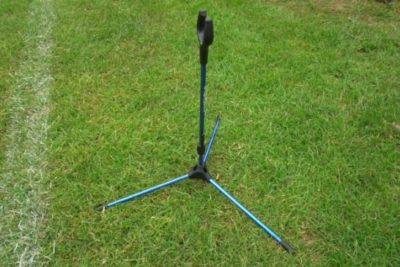
Bow Stand
A bow stand is designed to cradle your bow when not shooting and keep it off the ground – making sure that the bowstring stays clean and dry – and minimising damage to the bow.
Finger Sling
If your Olympic Recurve bow is balanced correctly, and your grip is correct while shooting – the bow will tend to roll forward after the arrow is released. The finger sling will simply prevent the bow from rolling forward and falling out of your hand while you follow through the shot.

Please seek advice from your fellow club members to make the most of your equipment, and to get opinions about items you might consider adding to your archery bag …
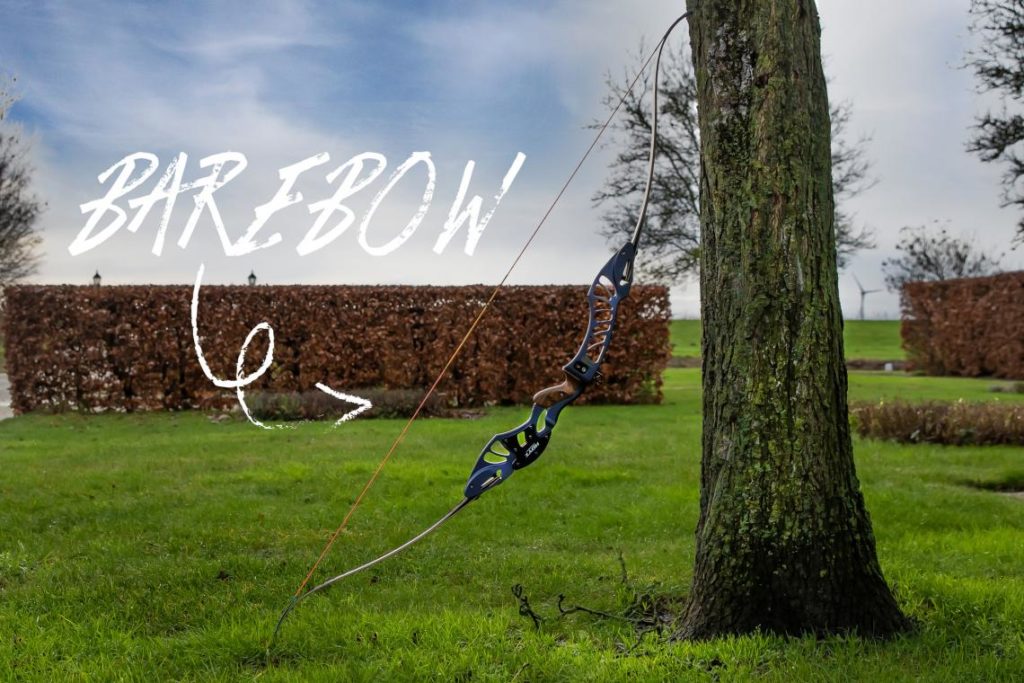
Barebow?
If you’d prefer a clean bow without a sight, clicker and stabilisers – then maybe Barebow is for you? … Check out the WA site to see what Barebow is all about.
